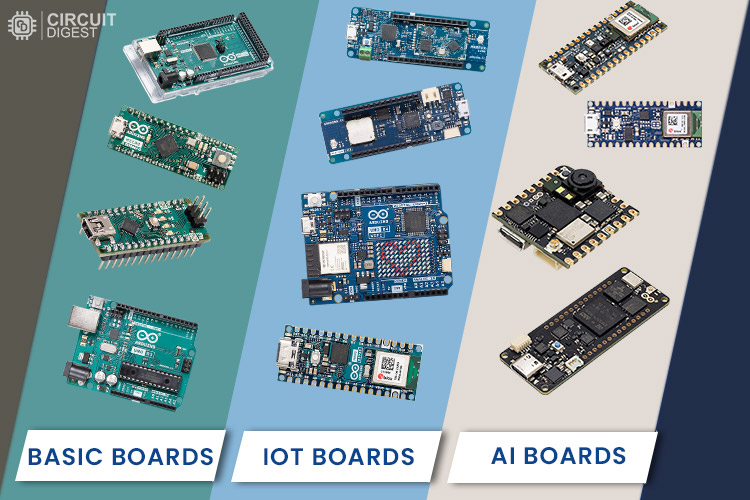
Whether you're a newbie just getting started with electronics and embedded systems or a professional Engineer planning your next big design project, Arduino has you all covered with a development board that best suits your requirements. For hobbyists and engineers, including me, the Arduino Platform has been the go-to place for quick prototyping and design validation. But most of us fail to explore beyond the popular Arduino development boards like the Arduino UNO, nano, mega, etc. So this tutorial is focused on bringing out all the different types of Arduino development boards and doing a quick comparison of their features and applications so that you will be able to make a better choice when you want something more than the popular UNO and nano boards for your next Arduino project. So, let's start…
Table of Contents
- Entry-Level Arduino Boards
- └ Arduino UNO R3
- └ Arduino Nano
- └ Arduino PRO Mini
- └ Arduino Leonardo
- └ Arduino Micro
- └ Arduino Nano Every
- └ Arduino Mega2560 Rev3
- └ UNO R4 Minima
- └ UNO Mini Limited Edition
- Arduino Boards with Enhanced Features
- └ Arduino Nano 33 BLE
- └ Arduino MKR Zero
- └ Arduino UNO WIFI Rev2
- └ Arduino Due
- └ Arduino MKR Vidor 4000
- └ Arduino Zero
- └ Arduino Nano 33 BLE Rev2
- Arduino IoT Boards
- └ UNO R4 WiFi
- └ Arduino Nano ESP32
- └ GIGA R1 WiFi
- └ Arduino Nano 33 IoT
- └ Arduino MKR FOX 1200
- └ Arduino MKR WAN 1300/1310
- └ Arduino MKR GSM 1400
- └ Arduino MKR WIFI 1010
- └ Arduino MKR NB 1500
- └ Arduino Nano RP2040 Connect
- Arduino AI Boards
- └ Nicla Sense ME
- └ Nicla Vision
- └ Nicla Voice
- └ Portenta X8
- └ Portenta H7 Lite Connected
- └ Portenta H7 Lite
- └ Portenta H7
- └ Portenta C33
- └ Arduino Nano 33 BLE Sense Rev2
- Classification of Arduino Boards Based on Application
- Latest Arduino boards in 2024
- Conclusion
Let's start with the below image that shows the most popular Arduino boards at the time of writing this article. Most of you reading this should be familiar with these names but if not, don't worry we will explore them all in this article.
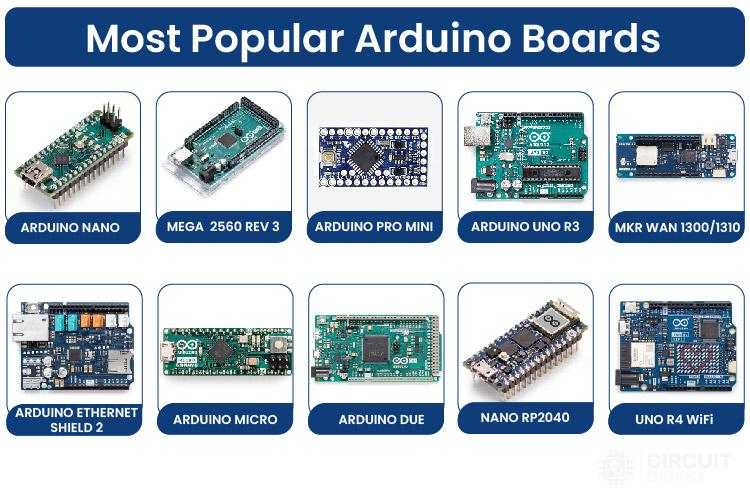
To make things quick and easy for you, we have split all the boards into three main categories, Entry Level Arduino boards, Enhanced Arduino boards, and IoT Arduino boards. Further, we have also provided a table under each section for quick skimming, so let’s get started.
Entry-Level Arduino Boards
These types of Arduino boards are the best choice to start with. In this category, most boards have either slow clock speed or a limited number of I/O ports. All these boards are powered by 8-bit microcontrollers. Most of them are easy to learn and make projects with. Not only that, there are a variety of modules and shield boards available on the market, especially targeting these base-level boards. Here is the table showing all the features of these boards.
*Click on the above image for full view
Arduino UNO R3
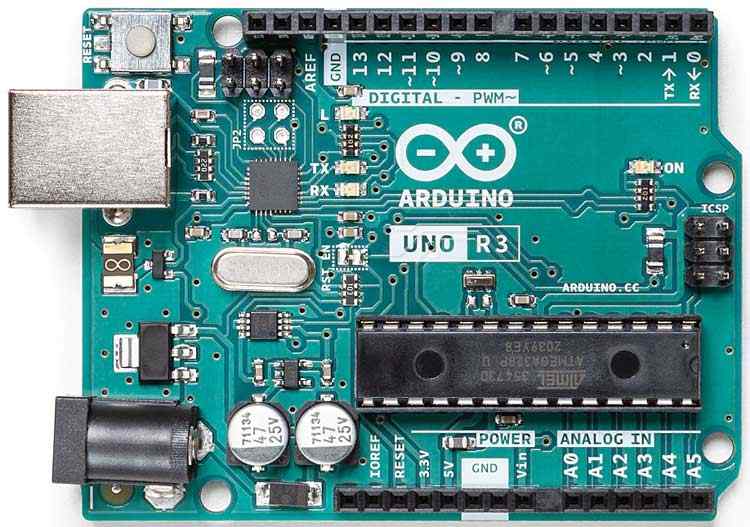
Arduino Uno is the most popular and widely used development board. It is powered by an ATMega328P microcontroller. It is the most popular choice among the community because it’s, cheap, easy to learn and use, and also a variety of premade modules are available for this which makes it easier for developing new projects or prototypes. It consists of 14 Digital I/O out of which 6 pins are 8bit PWM pins, 6 pins are 10-bit Analog inputs, and basic communication ports like SPI, I2C, and UART.
Now, there are many different types of Arduino UNO boards available across the global market, but most of these boards are the clone or copy versions of the original UNO board that you see above. Hence the color or the appearance of the board might be different than what is shown above.
Arduino Nano
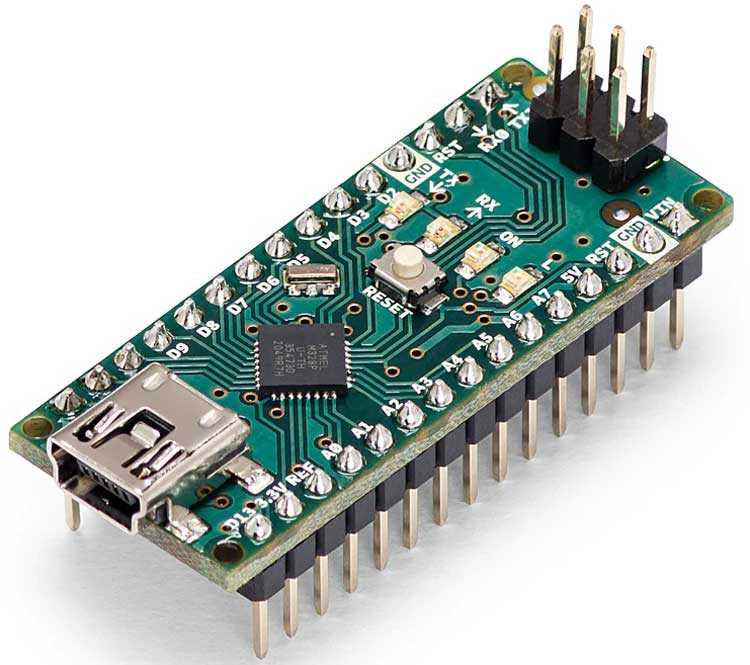
Arduino Nano is a small breadboard-friendly version of Arduino UNO. It has more or less the functionality of the Arduino UNO but in a small form factor. The only major differences from UNO are the lack of a DC power jack, the usage of a Mini USB port instead of a USB B port, and the USB-TTL converter chip. Nano uses an FT232, a dedicated USB-UART bridge chip from FTDI instead of an ATMega16U2. It is also a very popular choice among developers just like UNO because of its small size and cheap price.
Arduino PRO Mini
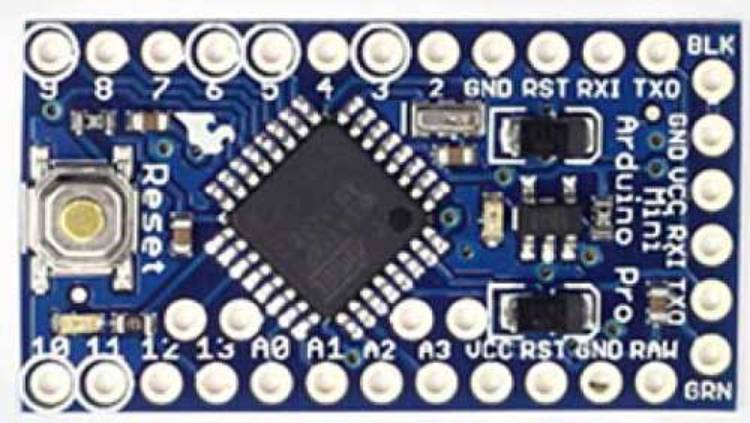
Pro mini is actually a cut-down version of Nano. It has most of the functionalities similar to Arduino Nano but it lacks the onboard USB -TTL bridge and the USB port. Instead, it has a header, in which the UART pins are brought out. We can use these pins to program the Pro mini using an external USB-UART module. This board is specially meant for applications where the space is limited. Pro mini is available in two versions, 3.3V, and 5v versions. In the 3.3V version, the CPU speed is limited to 8MHz because of certain limitations of ATMega328 for better stability.
Arduino Leonardo
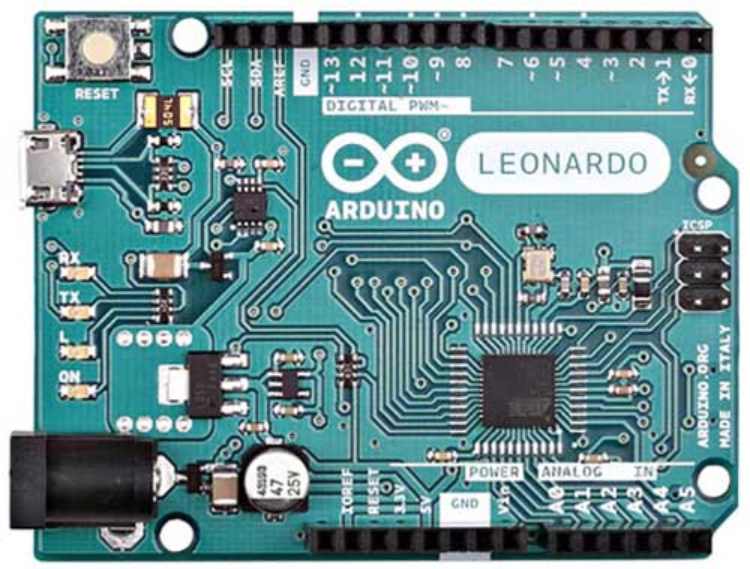
Arduino Leonardo is powered by an ATmega32U4 chip rather than the ATMega328P chip which is used in all the previously mentioned boards. It has more IO pins (20) and more PWM (7) and analog input (12) pins. One other major difference is that the ATMega32U4 has built-in USB communication eliminating the need for a second processor or a dedicated USB to UART bridge chip. This allows the board to connect to a computer as a Human Interface Device (HID) or as a Virtual (CDC) serial / COM port. We use this Virtual COM port along with the bootloader to program the Leonardo.
Arduino Micro
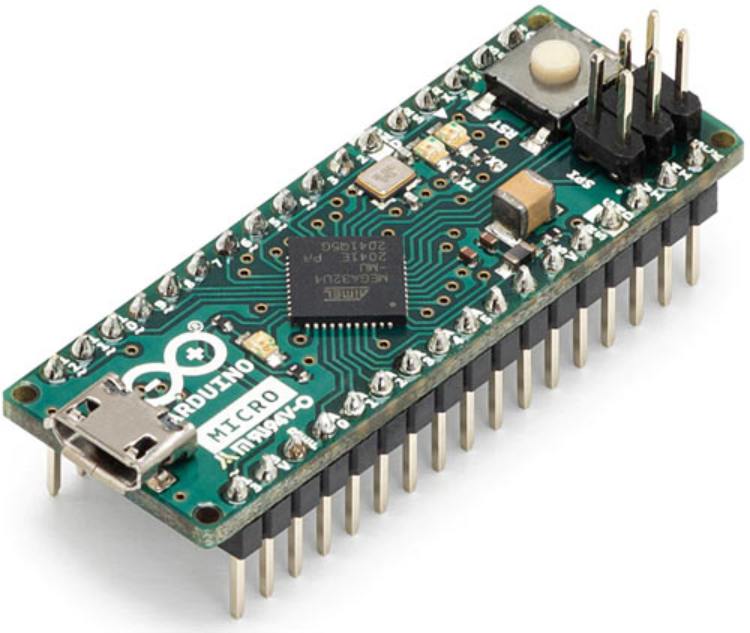
Just like Arduino Nano is a UNO in a small form factor, Arduino Micro is actually a Leonardo in a small form-factor breadboard-friendly sized board. Its functionalities are the same as the Arduino Leonardo. The only difference is the lack of a DC input jack. Similarly, Arduino Micro can also act as an HID or Virtual COM port device.
Arduino Nano Every
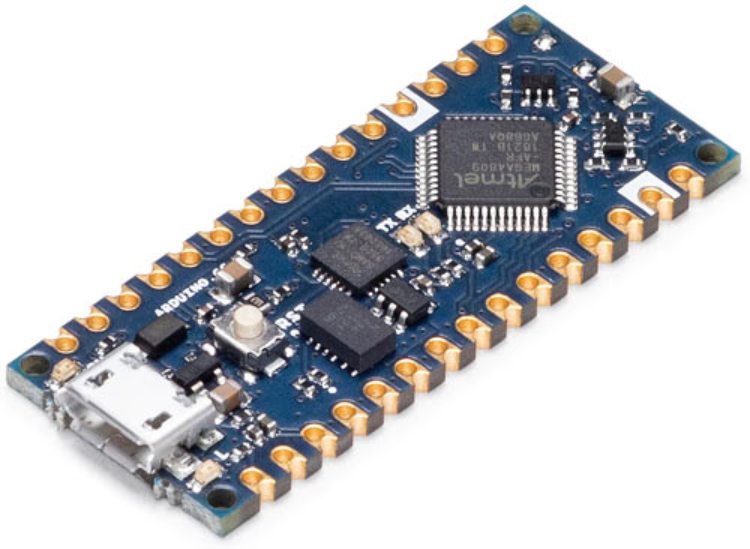
Arduino Nano Every is a new generation board in a small form factor. As we already discussed Arduino Nano is the preferred board for many projects requiring a small and cheap solution. We could call the Arduino Nano Every, an upgraded Arduino Nano with a lot more features. Nano Every is powered by a more powerful processor ATMega4809. It has 50% more program memory and 200% bigger RAM which will enable us to use this board for bigger programs. The castellated holes allow us to use the Nano Every on a PCB without the need for the header pins.
Arduino Mega2560 Rev3
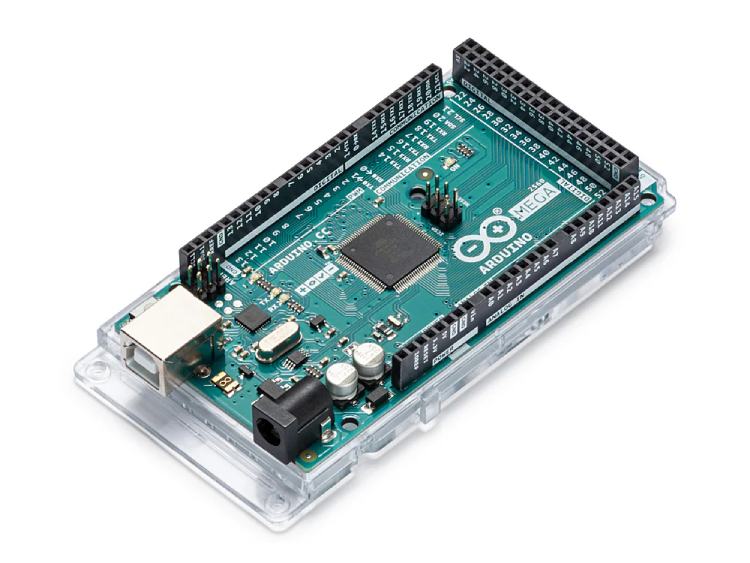
Arduino Mega 2560 is the biggest of all the boards we have discussed so far. It is designed for applications where a lot of I/O or peripherals are needed. It is powered by a bigger and more capable processor the ATMega2560. This board has the greatest number of I/O than most other boards, 54 I/O pins (of which 15 can be used as PWM outputs), 16 analog inputs, and 4 UARTs. It has more flash storage and SRAM than most other basic Arduino boards. It is most popular with the open-source CNC and 3D printer community as well as the open-source PLC community.
UNO R4 Minima
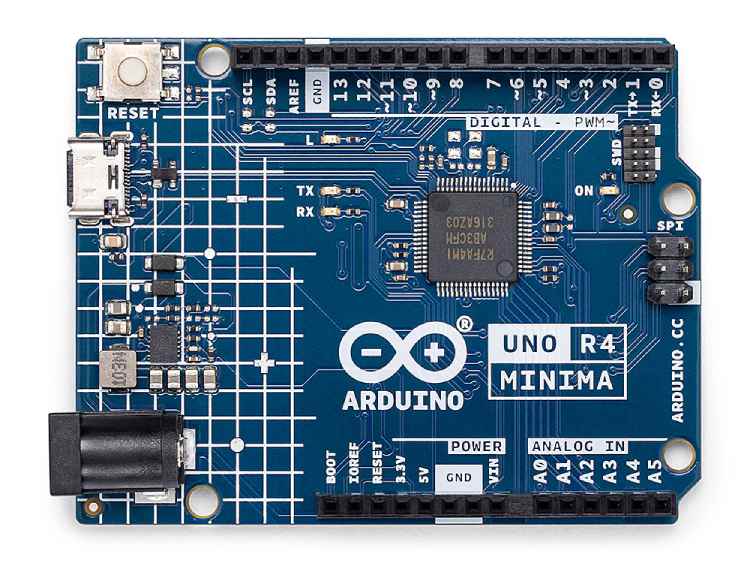
The UNO R4 Minima is the latest iteration of the popular Arduino microcontroller platform, known for its compact size and enhanced capabilities. As the successor to the UNO R3, the R4 Minima brings several improvements and new features. The Arduino UNO R4 Minima is the first UNO board featuring a 32-bit microcontroller, the RA4M1 from Renesas. The Renesas RA4M1 powering the R4 minima features an Arm Cortex-M4 and operates at a voltage of 5 V. It has 14 digital I/O, 6 analog inputs with up to 14-bit resolution, a clock speed of 48 MHz, and 32 kB SRAM, 256 kB flash memory & 8 kB of EEPROM. It also features a DAC for audio projects, RTC for accurate time tracking and HID for emulating a keyboard/mouse.
UNO Mini Limited Edition
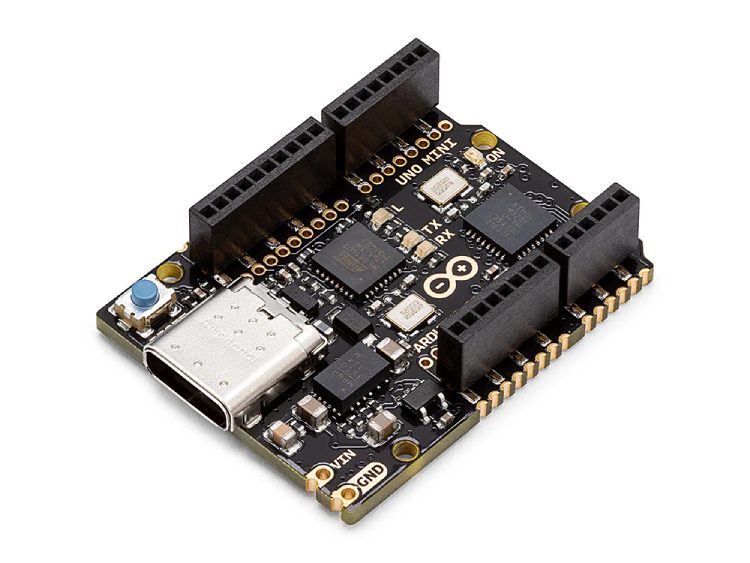
The UNO Mini Limited Edition is a special version of the iconic Arduino UNO, designed to celebrate the platform's legacy while offering a compact and collectable form factor. This limited-edition board features a distinctive design with unique graphics, a special color scheme, and a gold-plated PCB, adding a premium touch. Despite its smaller size, the UNO Mini retains the core functionality of the original, making it ideal for projects where space is limited. It's perfect for both collectors and developers who appreciate the blend of nostalgia and modern innovation. The UNO Mini Limited Edition encapsulates the spirit of the Arduino community, combining functionality with a unique, celebratory design.
Arduino Boards with Enhanced Features
Arduino boards in this category are meant for projects where advanced functionalities and faster performance are needed.
*Click on the above image for a full view
Arduino Nano 33 BLE
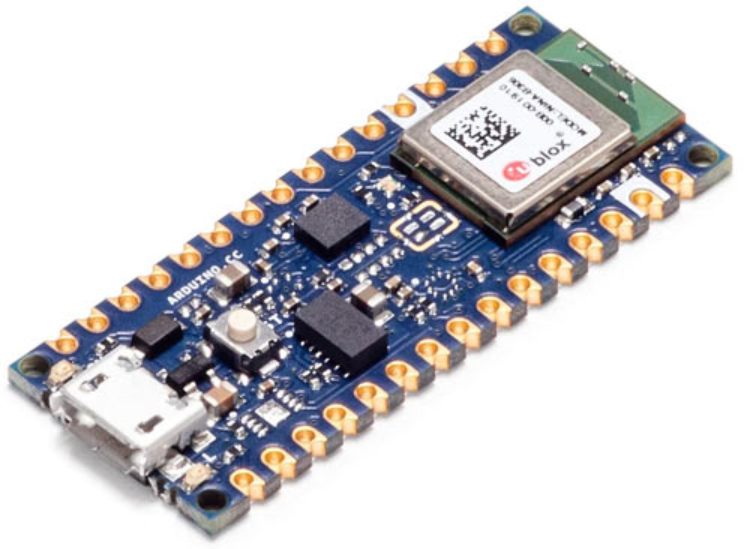
The Nano 33 BLE is a more powerful board from Arduino with the same form factor as the popular Arduino Nano. Even though it is the same size, it is more powerful than the Nano. It is powered by a more advanced NRF52480 from Nordic Semiconductors, a 32-bit ARM Cortex-M4 CPU running at 64MHz. The larger 1MB flash and 256KB SRAM make it the better choice where a lot of memory is needed. The main feature of this board is there in the name itself – BLE, Bluetooth Low Energy. The Nano 33BLE can be both BLE and Bluetooth client and the host device. In this era, where everything is connected together this will allow us to develop energy-efficient wearables.
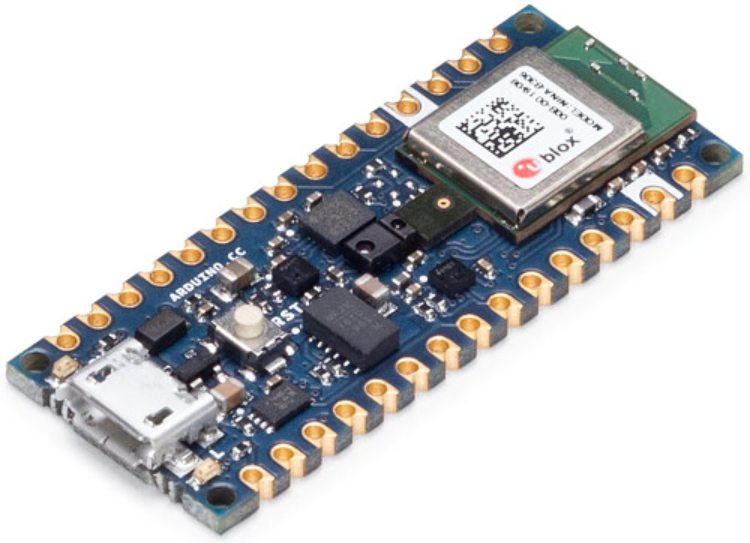
There is also another variant of Nana33 BLE available named Arduino Nano 33 BLE Sense with some additional sensors on board. Such as the 9-axis inertial sensor, humidity and temperature sensor, barometric sensor, microphone, and gesture, proximity, light colour, and light intensity sensor.
Arduino MKR Zero
Arduino MKR Zero
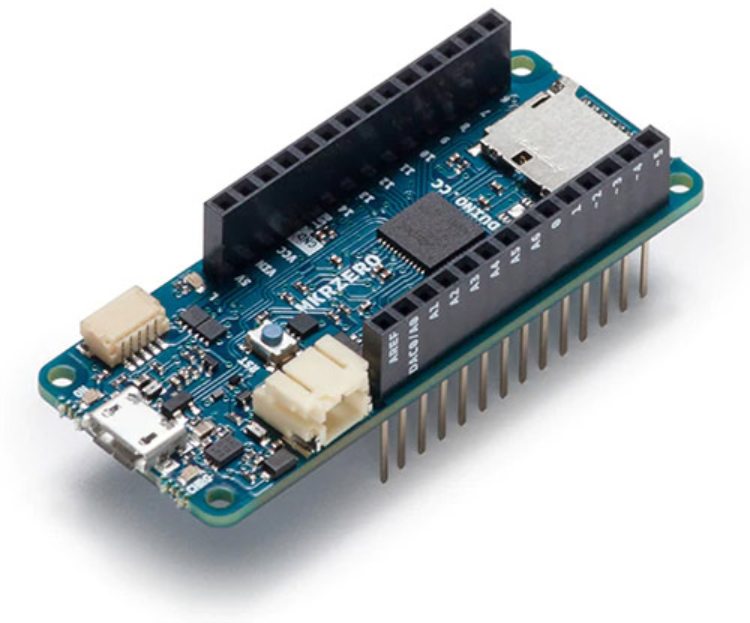
The Arduino MKR Zero is a development board meant for music makers or music-related projects. It has an onboard SD connector and dedicated SPI interface, which can be used for I2S communication. I2S is the most common communication protocol used for digital audio. The MKR Zero is powered by a powerful 32-bit ARM Cortex M0+ SAMD21 MCU. It’s a 3.3V device and not tolerable to 5V. Another main advantage of this board is that we can power it with a LiPo battery through the onboard Battery connector. The battery monitoring is also easy since the connection between the battery and the ADC is already implemented on the board.
Arduino UNO WIFI Rev2
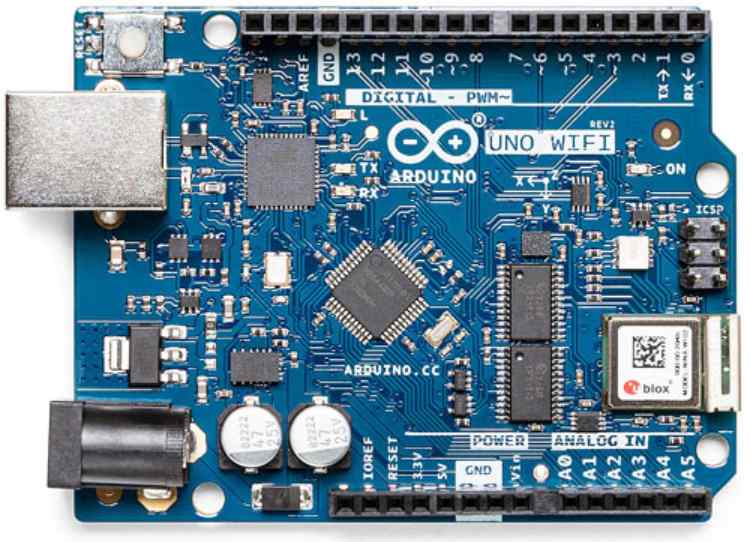
As the name suggests we can consider it as a UNO with an additional feature. Even though it is in the same form factor as Arduino Uno the components and features are entirely different. This board is powered by an ATMega4809 MCU and it uses u-blox NINA-W102 for WIFI and Bluetooth communication. The NINA SoC with an integrated TCO/IP protocol stack makes it easier to access a Wi-Fi network or to act as an access point. The board also has an onboard crypto chip accelerator, ECC608, for enhanced security and an IMU for Inertial measurement.
Arduino Due
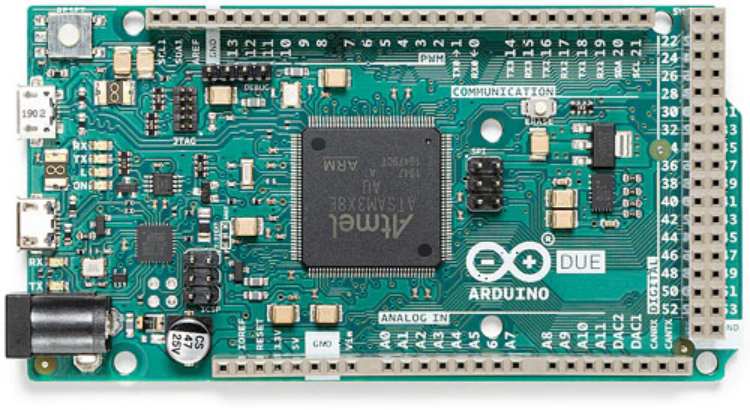
The Arduino Due is like an upgraded Arduino Mega and has the same form factor as the Mega but it is powered by a more powerful 32-bit ARM microcontroller. Just like Mega, Due has 54 Digital I/Os and 12 Analog inputs. The powerhouse of this board is an Atmel SAM3x8E Arm Cortex -M3 CPU. Due runs at a higher clock speed of 84MHz and has additional interfaces like USB OTG, DAC, and JTAG. Also, keep in mind that Due is a 3.3V-only device and its I/Os are not 5V tolerant.
Arduino MKR Vidor 4000
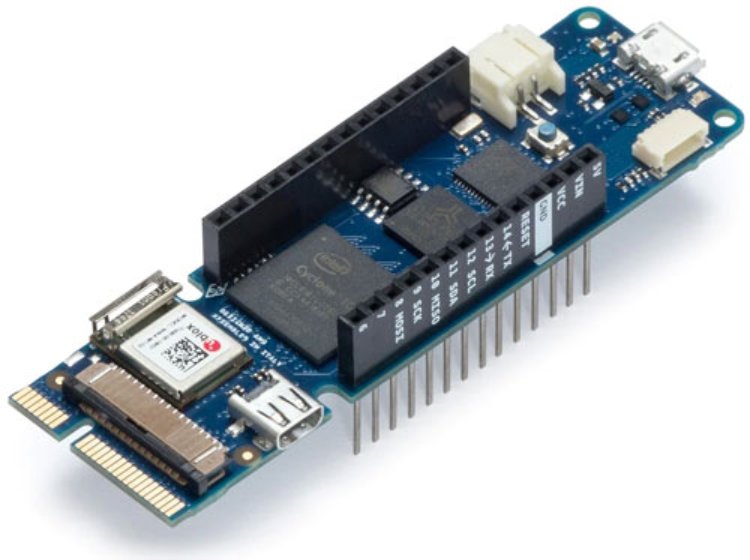
The Arduino MKR Vidor 4000 is a very special board with a very special feature that no other Arduino boards have – an onboard FPGA chip. With the onboard Intel Cyclone 10CL016 FPGA, this board is highly configurable and powerful. Vidor 4000 can perform high-speed digital audio and video processing. Even you can make your own controller within the FPGA. The board also has some more advanced features such as a Micro-HDMI connector, MIPI camera connector, and Wi-Fi and BLE powered by the NINA W102 module. It also supports LiPo batteries through the onboard connector. The Vidor 4000 is powered by SAMD21 Cortex M0+ MCU.
Arduino Zero
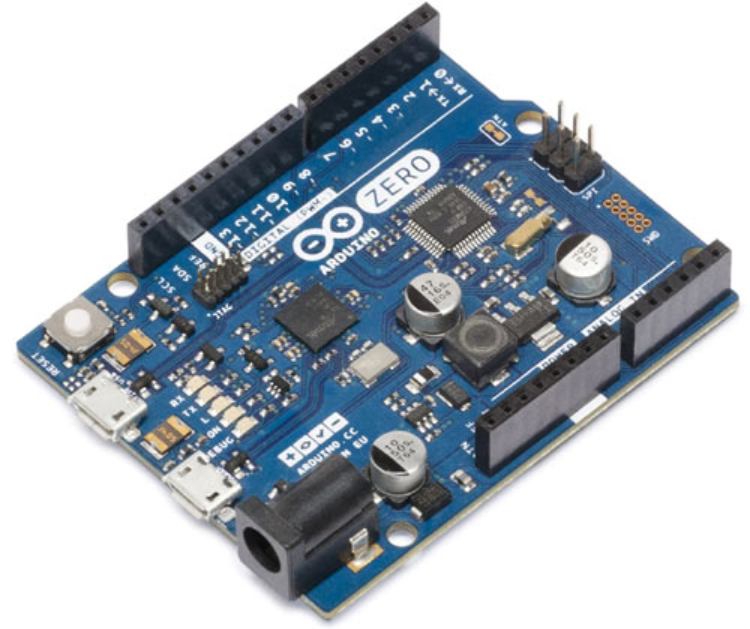
Arduino Zero is another board with the same form factor as the UNO. Even though the size and shape are the same, Arduino Zero is much more powerful and feature-rich than the UNO. The board is powered by Atmel’s SAMD21 MCU, which is a 32-bit ARM Cortex M0+ MCU. One of the important features of Arduino Zero is the Embedded Debugger or the EDBG, which provides a full debug interface without the need for an external debugger or any other additional hardware. EDBG also supports a virtual COM port, which can be used to program the board.
Arduino Nano 33 BLE Rev2
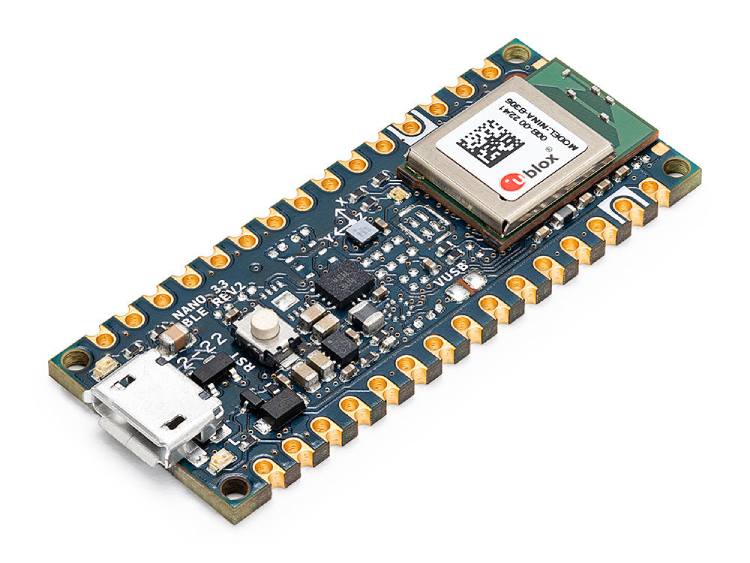
The Arduino Nano 33 BLE Rev2 stands at the forefront of innovation, leveraging the advanced capabilities of the nRF52840 microcontroller with a 32-bit Arm Cortex-M4 CPU operating at 64 MHz. This powerful development board, enhanced with MicroPython compatibility, becomes accessible to a broad community of developers, increasing its flexibility. Its standout feature is the Bluetooth Low Energy (Bluetooth LE) capability, enabling seamless communication with other Bluetooth LE-enabled devices and opening up a realm of possibilities for data sharing and integration with connected technologies. Designed for versatility, the Nano 33 BLE Rev2 includes a built-in 9-axis Inertial Measurement Unit (IMU) that provides precise measurements of position, direction, and acceleration, making it perfect for wearables and real-time motion tracking devices. Balancing size and features, it is ideal for crafting wearable devices that connect seamlessly to smartphones. Whether you're a seasoned developer or a hobbyist, the Nano 33 BLE Rev2 offers endless possibilities for innovation and creativity, elevating your projects with its power and flexibility.
Arduino IoT Boards
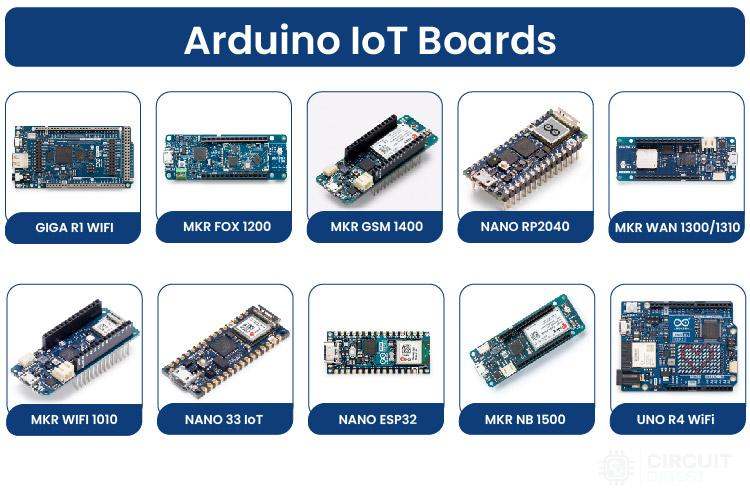
Nowadays many of the products we use are IoT-enabled, from a simple switch to all of the household appliances. The types of Arduino boards we are going to take a look at are designed for such applications. Let’s see which are these boards and what are their features.
*Click on the above image for full view
UNO R4 WiFi
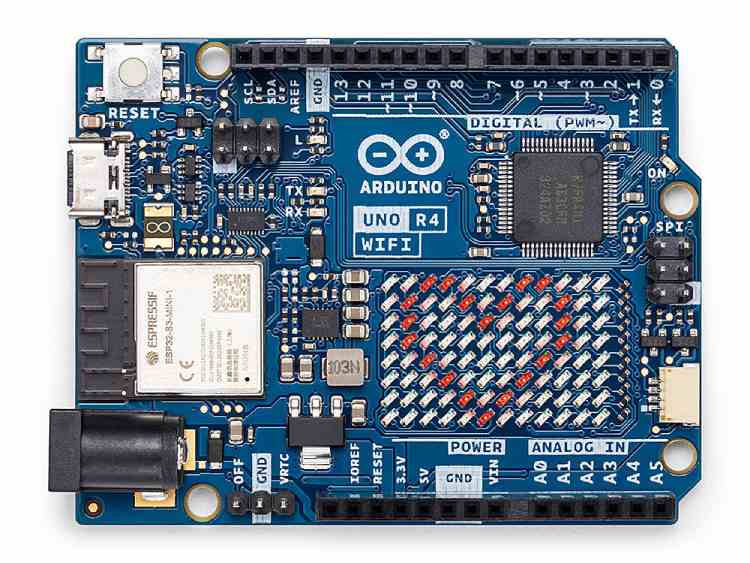
The Arduino UNO R4 WiFi is built around the 32-bit Renesas RA4M1 microcontroller and features an ESP32 module for Wi-Fi and Bluetooth connectivity. Its unique 12x8 LED matrix allows for direct visual prototyping on the board, and the inclusion of a Qwiic connector facilitates plug-and-play project creation. The high-performance Renesas RA4M1 (Arm Cortex-M4) microcontroller operates at a clock speed of 48 MHz, with 32 kB of SRAM and 256 kB of flash memory. This MCU also includes an RTC, DAC, CAN bus, and HID support via USB. Additionally, the UNO R4 WiFi integrates an ESP32-S3 for Wi-Fi/Bluetooth connectivity, which can be programmed separately through a dedicated header.
Nano ESP32
Arduino Nano ESP32
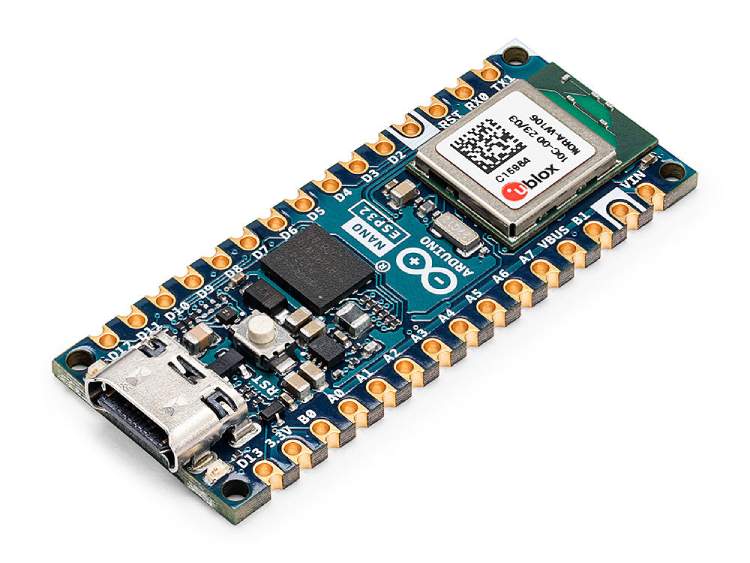
The Arduino Nano ESP32 is the first Arduino board to feature an ESP32 microcontroller from Espressif, housed within the NORA-W106 module from u-blox. Equipped with a USB-C connector and 16 MB (128 Mbit) of Flash memory, this versatile development board supports MicroPython and is Arduino Cloud enabled. The board also supports MicroPython and can be used for USB HID emulation.
GIGA R1 WiFi
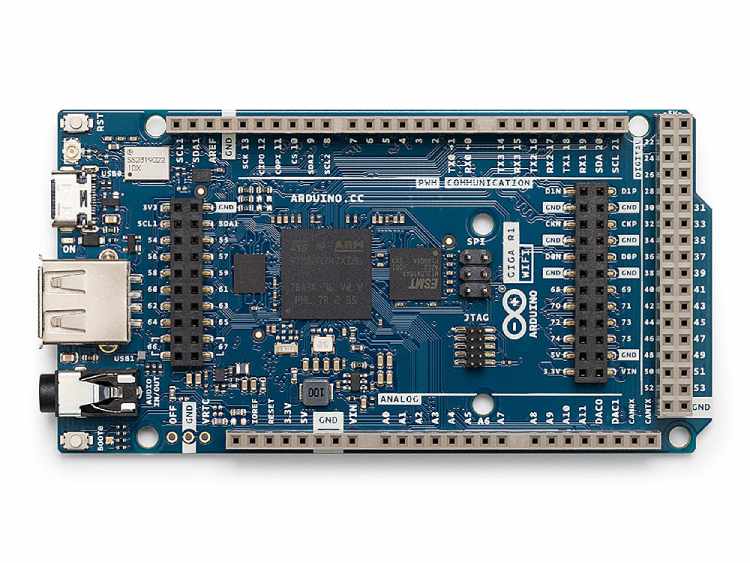
The GIGA R1 WiFi is a highly capable development board designed for complex, feature-intensive projects, powered by the STM32H747XI microcontroller running Mbed OS. It offers 76 GPIOs, dual-core processing at 480MHz and 240MHz, and advanced ADC/DAC capabilities, providing ample processing power for demanding applications. Extensive connectivity options, including camera and display connectors, enhance its multimedia project compatibility. For USB connectivity, the GIGA R1 WiFi features a USB-C port with HID support and a USB-A port for USBHost functions, such as keyboards and mass storage devices. The inclusion of a 3.5 mm audio jack allows for connecting speakers and microphones, further expanding its versatility. Additionally, the GIGA R1 WiFi is equipped with a radio module, a crypto chip, and an antenna, ensuring secure and efficient wireless communication. This comprehensive set of features makes the GIGA R1 WiFi an excellent choice for developing large-scale, sophisticated projects with robust connectivity and processing requirements.
Arduino Nano 33 IoT
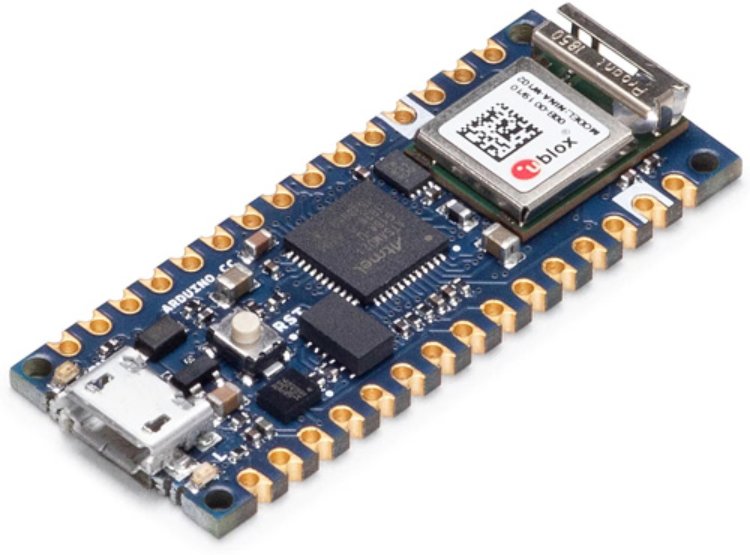
As the name suggests this’s board comes with the same form factor as a Nano. The board is powered by a low-power 32-bit ARM Cortex M0, Atmel’s SAMD21. The WiFi and Bluetooth connectivity is performed with a u-blox module, the NINA-W102. The Board also features a Microchip ECC60r crypto chip which ensures secure communication. Also, the onboard 6 aixs IMU enables the board to be used in projects which need or implement features such as vibration alarm, pedometer balancing, and relative positioning, etc. This board is also compatible with most of the IoT cloud services such as Arduino IoT cloud, Blynk, IFTTT, AWS IoT Core, Azure, Firebase, etc.
Arduino MKR FOX 1200
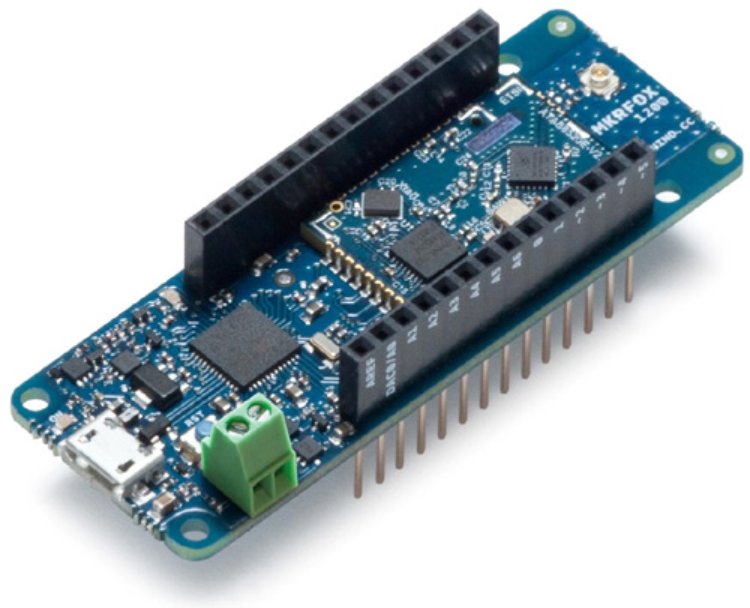
The Arduino MKR FOX 1200 is a cost-effective solution for Sigfox connectivity. The Sigfox is mostly used in the European region. The Sigfox infrastructure enables you to run projects to collect data around the clock without any maintenance or full-time supervision. This board is based on a SAMD21 MCU and the Microchip Smart RF ATA852o is used for the Sigfox connectivity.
Arduino MKR WAN 1300/1310
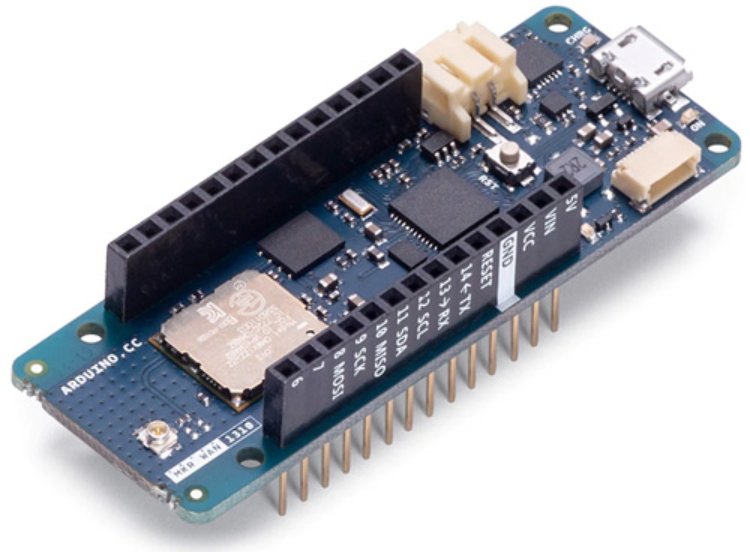
The MKR WAN 1300 and MKR WAN 1310 boards use LoRa connectivity for communications. MKR WAN 1310 is an upgrade version of MKR WAN 1300. Both boards use a SAMD21 low power processor, Murata CMWX1ZZABZ LoRa module, and the ECC508 Crypto chip. The MKR WAN 1310 includes a new battery charger, 2MB SPI flash, and improved power consumption. Both boards support 433/868/915 MHz frequency bands.
Arduino MKR GSM 1400
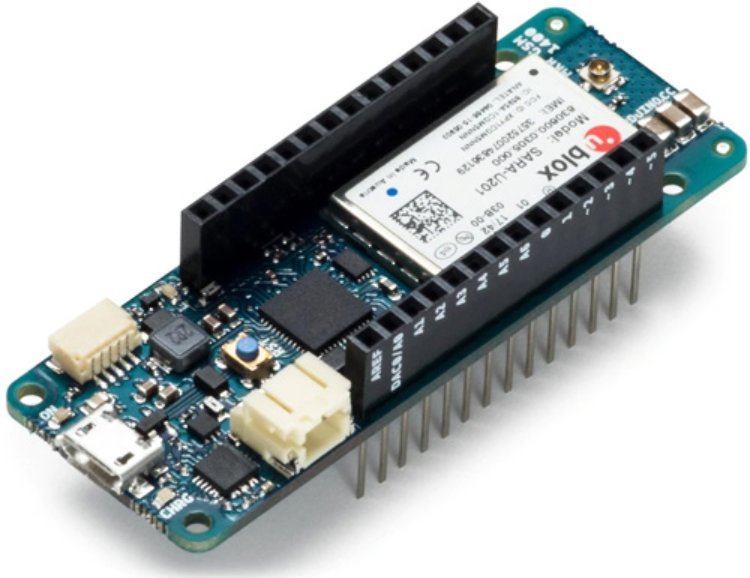
The Arduino MKR GSM 1400 takes advantage of the cellular network for communication. As similar to all other MKR boards this one is also powered by a SAMD21, 32-bit ARM Cortex M0 MCU. SARA-U201 module from u-bolx is used for the GSM/3G connectivity. This board supports cellular bands such as GSM 850MHz, E-GSM 1900MHz, DSC 1800MHz, and PCS 1900MHz. Same as many other MKR boards onboard ECC508 crypto chip ensures secure communication. This board supports a Li-Po battery, which makes it an ideal candidate for any portable project.
Arduino MKR WIFI 1010
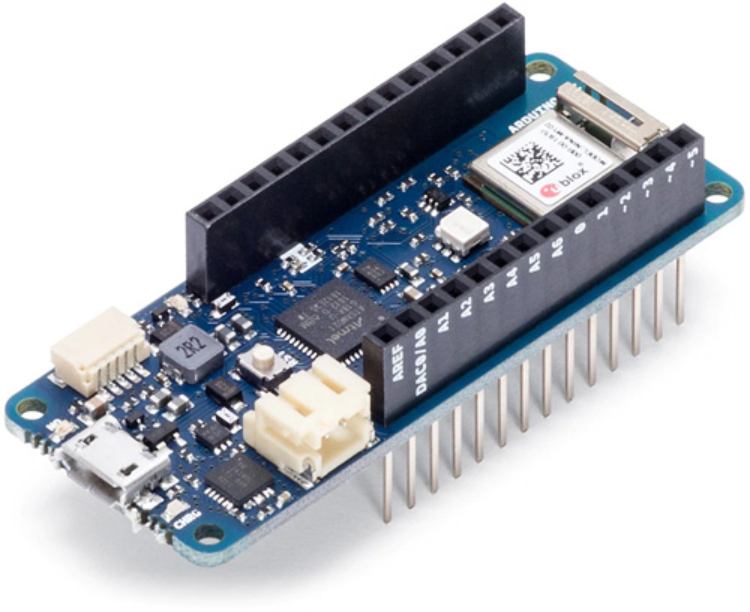
The MKR WiFi 1010 is the best choice for basic IoT and pico-network applications. It can be powered from a LiPo battery. MKR WiFi 1010 uses the NINA-W102 module for communication and ECC5087 as a crypto chip same as many other MKR boards. You can also find an RGB LED on board.
Arduino MKR NB 1500
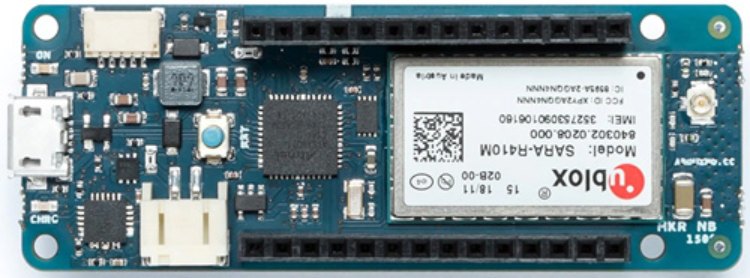
The NKR NB 1500 enables you to add narrowband communication to your project which is a perfect choice for projects or devices meant to be used in a remote location where internet connection is not feasible or in situations where powering the device is a challenge such as field deployments, remote monitoring, solar-powered devices, etc. The onboard SARA-R410M-02B module supports many Cat M1/NB1 bands such as 1, 2, 3, 4, 5, 8, 12, 13, 18, 19, 20, 25, 26, 28. The board also features an onboard battery charger and a connector for an external antenna.
Arduino Nano RP2040 Connect
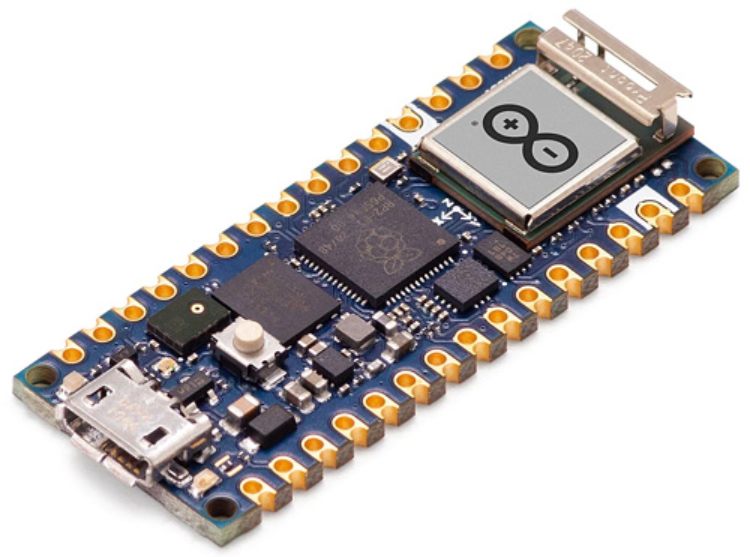
Last but not least the Arduino Nano RP2040 Connect is the newest addition to the Arduino family. It features the rather popular, raspberry Foundation’s first in-house chip, the RP2040. The RP2040 is a dual-core ARM Cortex M0+ SoC running at 133MHz and it has 264KB SRAM and 16MB external flash chip. Not only that the board has NINA-W102 for both WiFi and BLE connectivity. A built-in mic is there for sound activation, Audio control, and even voice recognition. There is also a 6 axis IMU onboard. The board is also RPi Pico compatible.
Arduino AI Boards
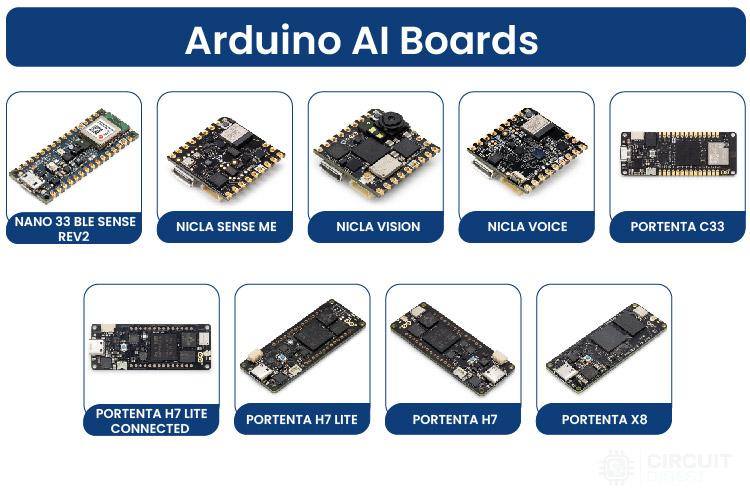
Arduino AI boards are designed to simplify the integration of artificial intelligence into various projects. These boards combine Arduino's accessible hardware with AI-specific features such as edge and machine learning, making them suitable for developers and hobbyists looking to implement machine learning, data analysis, and intelligent automation. Equipped with advanced microcontrollers these boards support real-time data processing and decision-making. Their applications range from smart home devices and predictive maintenance to interactive robotics and educational tools. By integrating seamlessly with the Arduino ecosystem, these AI boards provide a versatile platform for developing sophisticated, AI-driven solutions.
Nicla Sense ME
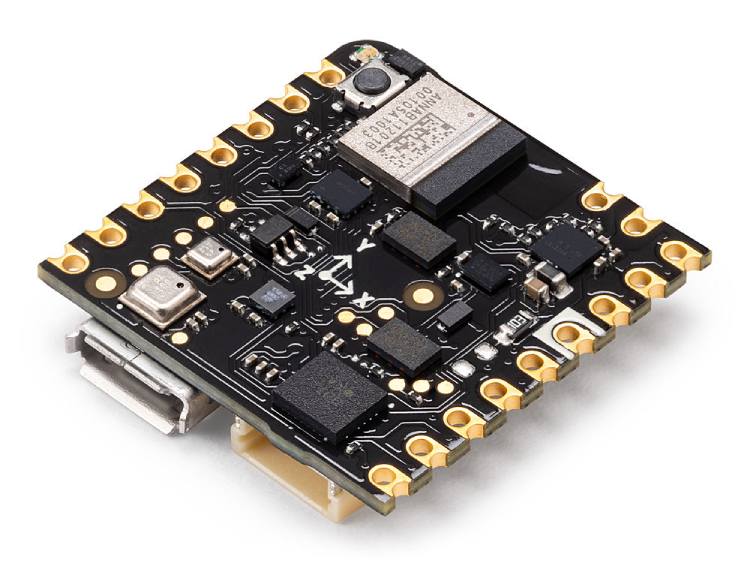
The Arduino Nicla Sense ME is a compact and powerful development board designed for advanced sensing applications. This tiny form factor board is packed with industrial-grade sensors, making it ideal for measuring parameters such as temperature, humidity, and movement. It features a 9-axis inertial measurement unit and supports Bluetooth Low Energy connectivity, enabling wireless sensing networks. The Nicla Sense ME integrates four state-of-the-art Bosch Sensortec sensors: the BHI260AP motion sensor system with integrated AI, the BMM150 magnetometer, the BMP390 pressure sensor, and the BME688 4-in-1 gas sensor. These sensors allow the board to measure rotation, acceleration, pressure, humidity, temperature, air quality, and CO2 levels. Designed for easy motion and environmental analysis, the Nicla Sense ME is suitable for projects requiring sensor fusion and AI capabilities at the edge. With low power consumption and strong computational power, it can function as a standalone battery-powered board.
Nicla Vision
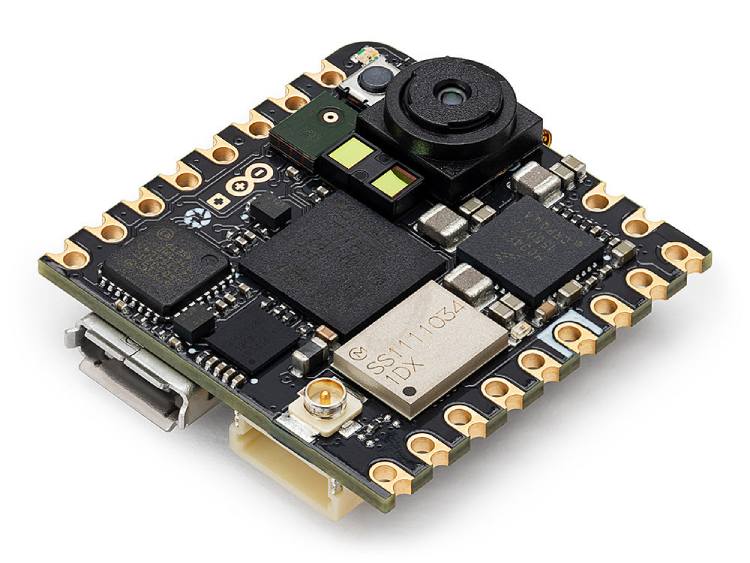
The Nicla Vision is a compact and powerful development board, measuring just 22.86 x 22.86 mm, that combines advanced processing and sensing capabilities. It features a STM32H747AII6 Dual ARM Cortex M7/M4 processor and a 2MP colour camera, supporting TinyML for on-device image processing and machine vision. The board also includes a smart 6-axis motion sensor, integrated microphone, and distance sensor, making it ideal for applications like asset tracking, object recognition, and predictive maintenance. Designed for easy integration, the Nicla Vision is compatible with all Arduino Portenta and MKR products and fully integrates with OpenMV, supporting MicroPython. It offers both WiFi and Bluetooth Low Energy connectivity for flexible and wireless project deployment. With low power consumption, it enables battery-powered, standalone applications, making it a versatile solution for edge AI and machine vision projects. The Nicla Vision's powerful processor and compact design simplify the development and prototyping of intelligent sensing solutions, allowing developers to efficiently handle detailed image recognition and processing tasks while focusing on the bigger picture.
Nicla Voice
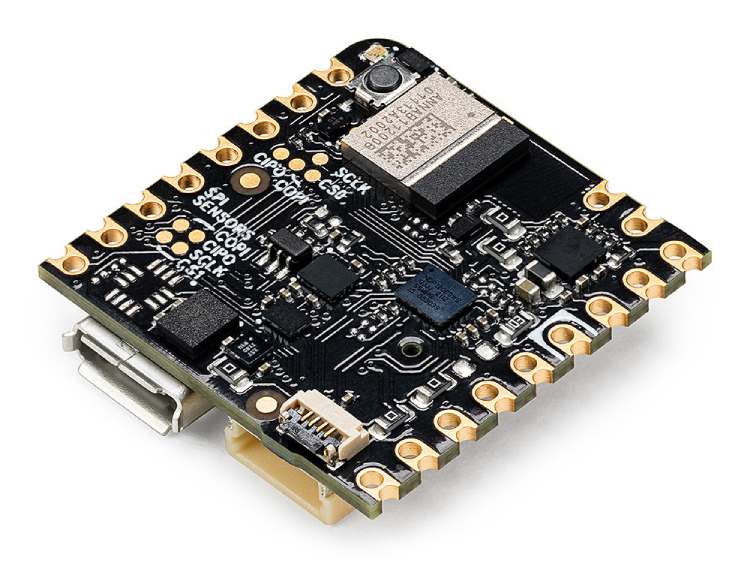
The Arduino Nicla Voice is a compact board, measuring just 22.86 x 22.86 mm, designed to bring speech and motion recognition capabilities to edge computing. It integrates the powerful NDP120 Neural Decision Processor, which supports multiple AI algorithms simultaneously for efficient on-device processing. The board includes a built-in microphone, nRF52832 microcontroller, Bluetooth Low Energy module, 6-axis IMU, and a 3-axis magnetometer, making it ideal for creating low-power wireless sensor networks for machine learning applications. Nicla Voice excels in implementing always-on speech recognition at the edge, leveraging Syntiant’s NDP120 processor to run advanced machine-learning algorithms inspired by biological systems. This makes it perfect for applications such as predictive maintenance, gesture and voice recognition, and contactless controls. It offers onboard Bluetooth Low Energy connectivity, ensuring easy interaction with existing devices and compatibility with Nicla, Portenta, and MKR product lines. With ultra-low power consumption, Nicla Voice allows for 24/7 sensor data processing, even in battery-powered standalone applications, and is compact enough for use in wearables or retrofitting existing machinery, providing a seamless and energy-efficient solution for integrating AI-based voice recognition on the edge.
Portenta X8
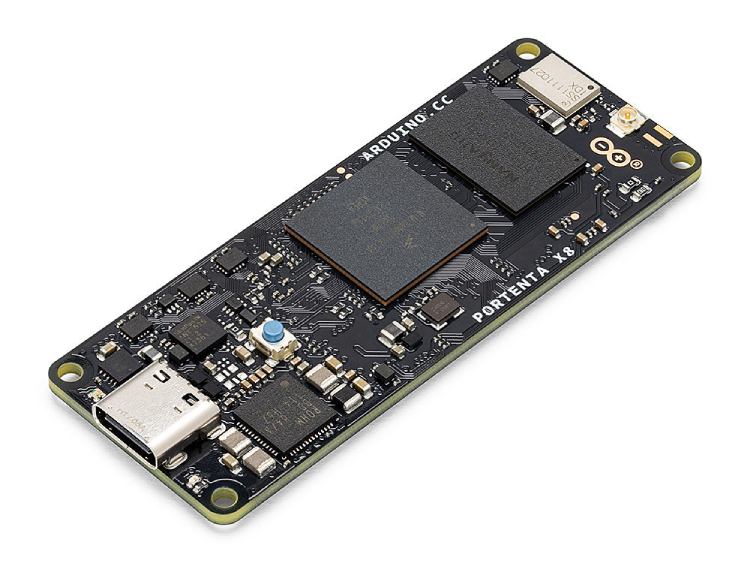
The Portenta X8 is a high-performance, industrial-grade system on module (SOM) that integrates dual microprocessors: the NXP i.MX 8M Mini MPU running Linux and the STM32H747XI dual-core ARM Cortex-M7+M4 MCU running Arduino. This combination provides robust processing capabilities for Industrial Internet of Things (IIoT) applications, enabling both real-time tasks and high-performance computing. The board supports a modular container system, allowing for secure and controlled application deployment without the need for additional subscription services, and users can manage custom containers, making the board versatile and flexible for various projects. With nine processing cores in total, including four Cortex-A53 up to 1.8GHz, one Cortex-M4 up to 400MHz, and dual STM32H747 cores (Cortex-M7 up to 480MHz and Cortex-M4 up to 240MHz), the Portenta X8 delivers exceptional computational power in a compact form factor. It features Wi-Fi and Bluetooth Low Energy connectivity for secure OTA updates and supports popular programming languages such as Python, Java, and Ruby. Security is a top priority, with the NXP SE050C2 hardware security element ensuring secure operations and storage. The board is PSA Certified, Arm SystemReady certified, and integrates Parsec services. Ideal for connected edge computing, autonomous guided vehicles, secure kiosks, smart agriculture, and behavioural analytics, the Portenta X8 can be expanded with accessories like the Portenta Breakout or Portenta Max Carrier. For businesses, Arduino Cloud for Business with Portenta X8 Board Manager offers secure Linux maintenance, individual provisioning keys, and OTA updates for containerized applications.
Portenta H7 Lite Connected
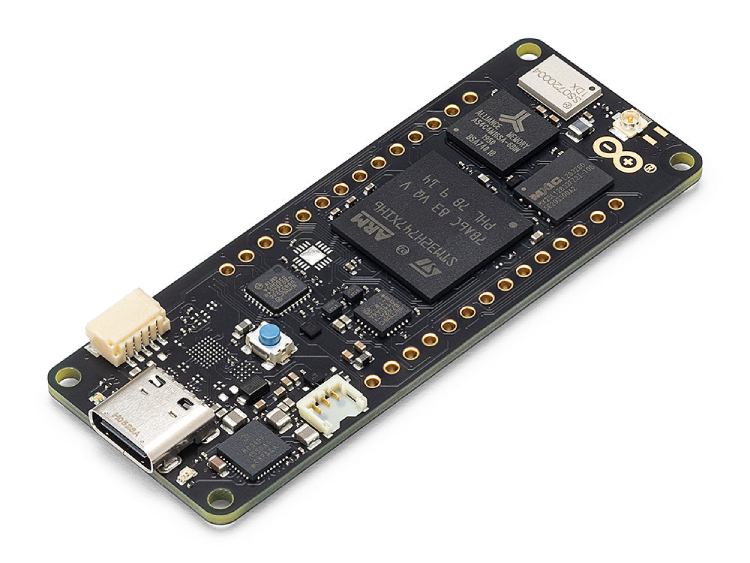
The Portenta H7 Lite Connected, adhering to the Arduino MKR form factor, enhances functionality with the Portenta family 80-pin high-density connector. This powerful module allows programming in high-level languages and AI while performing low-latency operations on its customizable hardware. Designed to bridge the gap between the full H7 and H7 Lite versions, it offers wireless connectivity, providing an ideal solution for Arduino Pro clients seeking a balance of performance and simplicity. With its dual-core STM32H747 processor (Cortex M7 at 480 MHz and Cortex M4 at 240 MHz), the H7 Lite Connected can execute Arduino-compiled and MicroPython code simultaneously, enabling real multitasking via Remote Procedure Call. This makes it perfect for running machine learning algorithms alongside low-latency sensor/actuator interactions. Key benefits include AI on the edge capabilities, an onboard wireless module for WiFi and Bluetooth connectivity, high-level programming language support, and robust security features with an onboard secure element. Versatile in application, it can function as an embedded microcontroller board or the main processor of an embedded computer. When paired with the Portenta Vision Shield, it transforms into an industrial camera capable of real-time machine learning on live video feeds. The H7 Lite Connected is ideal for high-end industrial machinery, laboratory equipment, computer vision, PLCs, robotics controllers, and mission-critical devices, making it an indispensable component for cutting-edge computational tasks.
Portenta H7 Lite
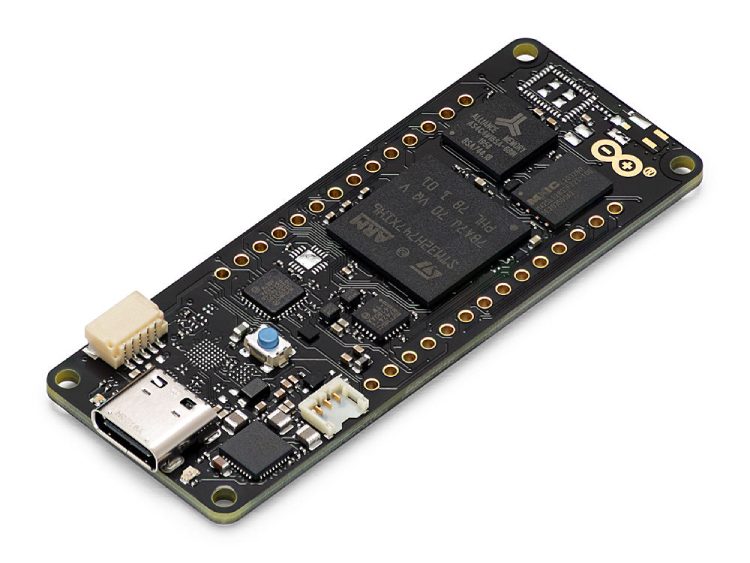
The Portenta H7 Lite is an economical solution designed for environments where radio communication is impractical, ideal for developers seeking the computational power of the Portenta H7 without the need for video output or advanced security features. It excels in running high-level code and real-time tasks simultaneously, powered by a dual-core STM32H747 processor (Cortex M7 at 480 MHz and Cortex M4 at 240 MHz), enabling concurrent execution of Arduino-compiled and MicroPython code with seamless inter-core communication. Key benefits include dual-core processing for parallel tasks, AI on the edge capabilities, high customizability in volumes, and support for high-level programming languages like MicroPython. The Portenta H7 Lite can function as both a traditional embedded microcontroller board and the main processor of an embedded computer. Combined with the Portenta Vision Shield, it transforms into an industrial camera capable of real-time machine learning on live video feeds, allowing one core to compute computer vision algorithms while the other manages low-level operations like motor control or user interface tasks. The H7 Lite is perfect for applications such as high-end industrial machinery, laboratory equipment, computer vision, PLCs, robotics controllers, and mission-critical devices, ensuring high-speed booting and robust performance. It supports Arduino sketches on top of Arm Mbed OS, native Mbed applications, MicroPython/JavaScript via an interpreter, and TensorFlow Lite, making it a highly adaptable tool for developers.
Portenta H7
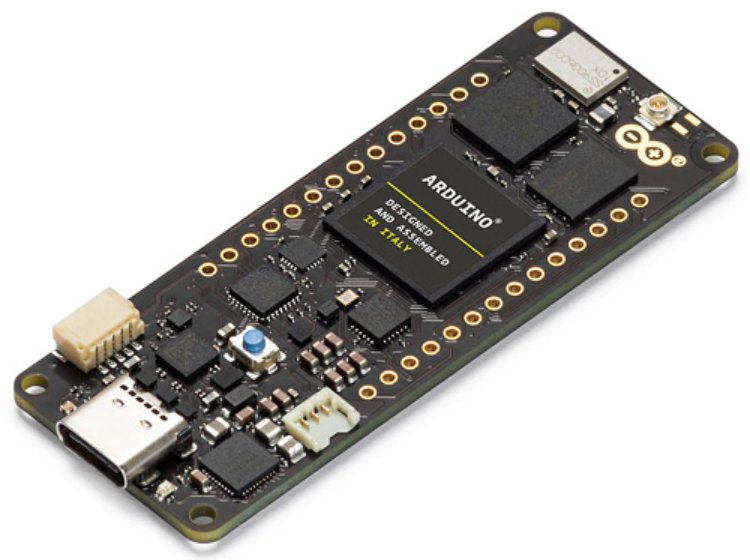
The Protenta H7 is capable of running High-level code along with real-time tasks simultaneously. Protenta H7 is meant for applications such as High-end industrial machinery, Laboratory equipment, Computer vision, PLCs, Industry-ready user interfaces, Robotics controllers, Mission-critical devices, Dedicated stationary computers, High-speed booting computation, etc.
The H7 is powered by a dual-core STM32XX, which features a Cortex M7 core running at 480MHz and a Cortex M4 core running at 240MHz. The two cores communicate through a process called Remote Procedure Call or in short RPC, which is used in most modern desktop CPU architectures such as x86, x64, Power PC, etc. The STM32H747 also features an on-chip GPU, the Chrom-ART Accelerator, and a dedicated JPEG encoder and decoder.
Portenta C33
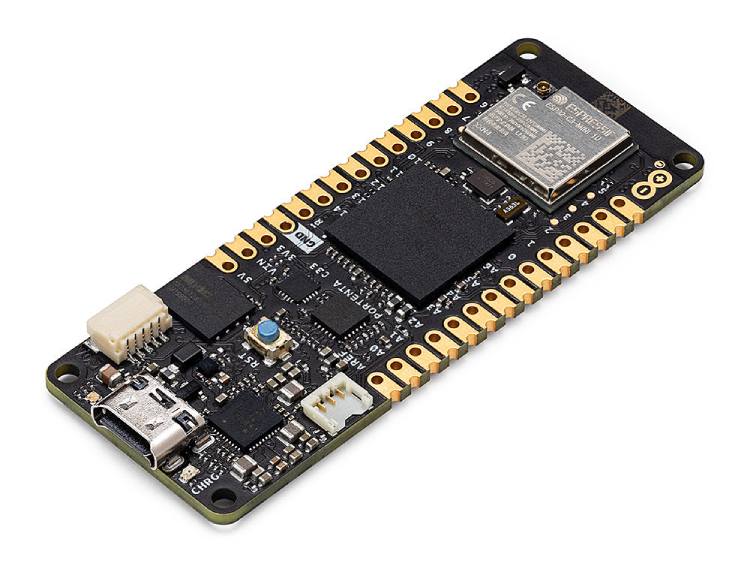
The Portenta C33 is a streamlined module designed to deliver the high-performance characteristic of the Portenta family at a more affordable price point, achieved through optimizations and streamlined features. Powered by the Arm Cortex-M33 microcontroller from Renesas, it is perfect for developing cost-effective, real-time applications. Supporting high-level programming languages like MicroPython, the Portenta C33 features onboard Wi-Fi and Bluetooth Low Energy connectivity, making it ideal for IoT gateways, remote control systems, fleet management, and process tracking. Industrial-grade security is ensured with its secure element, and the module supports over-the-air firmware updates via Arduino IoT Cloud or other third-party services. AI-powered projects are easily deployable with a wide array of ready-to-use software libraries and Arduino sketches, alongside real-time data display on Arduino IoT Cloud-based dashboards. Its form factor is compatible with the Portenta and MKR ranges and includes castellated pins for efficient automatic assembly line integration. Key benefits include suitability for low-cost IoT applications, support for high-level programming languages, secure OTA updates, and compatibility with Arduino's ecosystems. Designed for reliability, security, and computational efficiency, the Portenta C33 enhances efficiency and automation, making it suitable for applications such as industrial IoT gateways, machine monitoring, inline quality control, energy consumption monitoring, appliance control systems, and ready-to-use IoT prototyping solutions. The Portenta C33 brings a wide range of applications within reach, enabling quick plug-and-play prototyping and offering a cost-effective solution for industrial-scale projects.
Arduino Nano 33 BLE Sense Rev2
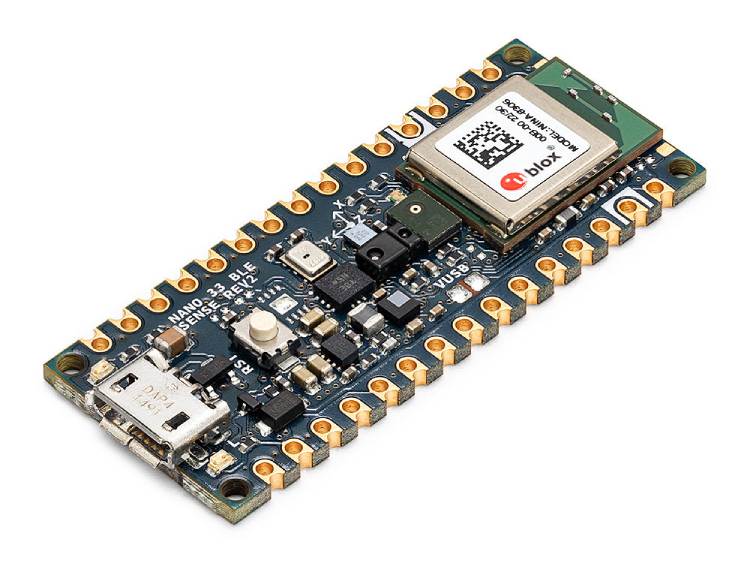
The Arduino Nano 33 BLE Sense Rev2 is Arduino’s compact, 3.3V AI-enabled board, designed with a comprehensive set of sensors that allow you to start programming your next project immediately without the need for external hardware. This versatile board is perfect for building wearable devices that use AI to recognise movements, room temperature monitoring devices that can suggest or modify thermostat settings, and gesture or voice recognition devices utilising the onboard microphone or gesture sensor in conjunction with AI capabilities. The standout feature of the Nano 33 BLE Sense Rev2 is its ability to run Edge Computing applications using TinyML, enabling advanced projects like real-time AI processing. Users can learn to utilise the TensorFlow Lite library or train their board using Edge Impulse, making this board an excellent choice for innovative AI-driven projects.
Classification of Arduino Boards Based on Application
Arduino boards can be categorized into three different types based on the area of applications - Arduino Embedded boards, Arduino IoT boards and Arduino AI boards. Arduino-embedded boars are the ones used for generic or all-around applications. Arduino IoT boards are meant for IoT applications with network connectivity options. Arduino AI boards are meant for AI-related projects such as machine learning, edge computing etc. Many boards may overlap into these categories, but we have listed them based on their primary targeted usage.
| Types Of Arduino Embedded Boards | Uno R3 | Nano | Pro Mini | Leonardo |
| Uno WiFi | Nano Every | Mega2560 Rev 3 | Micro | |
| Uno Mini | Nano 33 BLE | MKR Zero | Due | |
| Uno R4 Minima | Nano 33 BLE Rev 2 | MKR Vidor 4000 | Zero | |
| Types Of Arduino IoT Boards | Uno R4 WiFi | Nano ESP32 | Giga R1 WiFi | Nano 33 IoT |
| MKR FOX 1200 | MKR WAB 1300 | MKR WAN 1310 | ||
| MKR GSM 1400 | MKR WiFi 1010 | MKR NB 1500 | Nano RP2040 Connect | |
| Types Of Arduino AI Boards | Nicla Sense ME | Nicla Vision | Nicla Voice | Protenta C33 |
| Protenta X8 | Protenta H7 | Protenta H7 Lite | Protenta H7Connect |
Latest Arduino boards in 2024
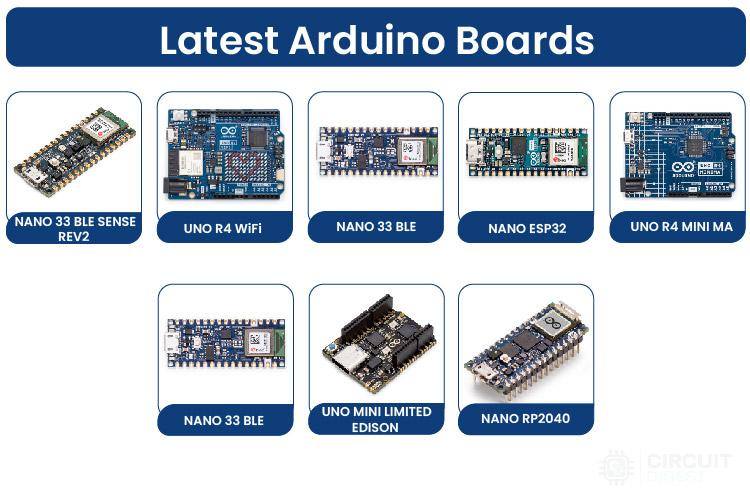
Arduino launched a lot of new development boards by end of 2023 and 2024. The below shows the latest arduino boards that are worth checking out. We are writing this article on May 2024; the list will be updated if any newer bords are added and we think it is worth considering.
Conclusion
We hope that everyone has a better understanding of different Arduino boards and their features. So, which Arduino is best for you will entirely depend on your needs. If you are a starter or if you are doing projects that don’t require a lot of computing power or onboard communication you may choose the most popular UNO or Nano as they are cheap and easy to program. When you need a more advanced board you may select one from the above list depending on your requirements.

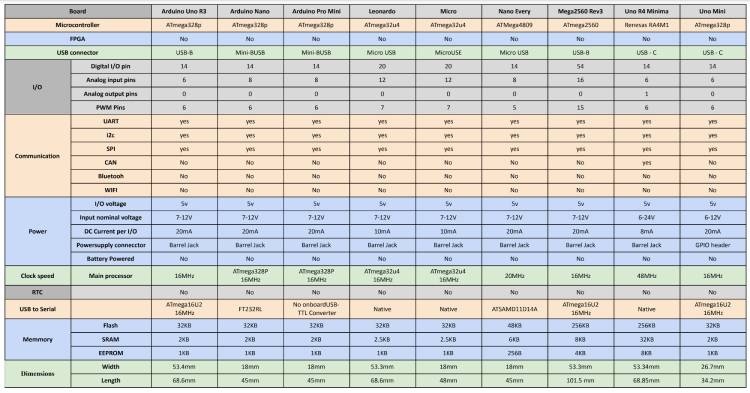
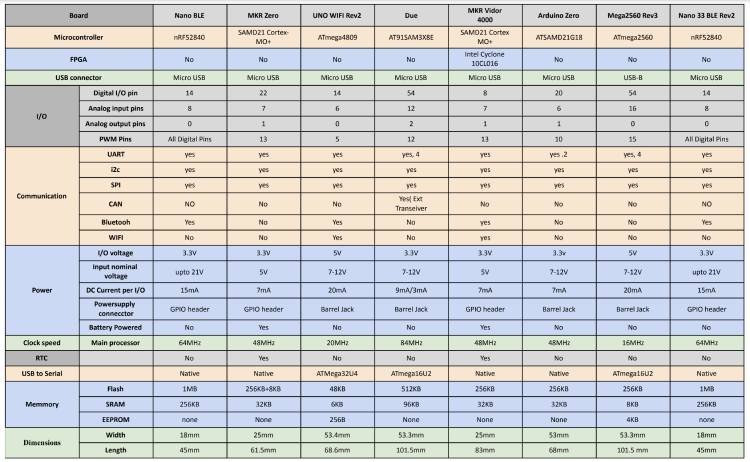
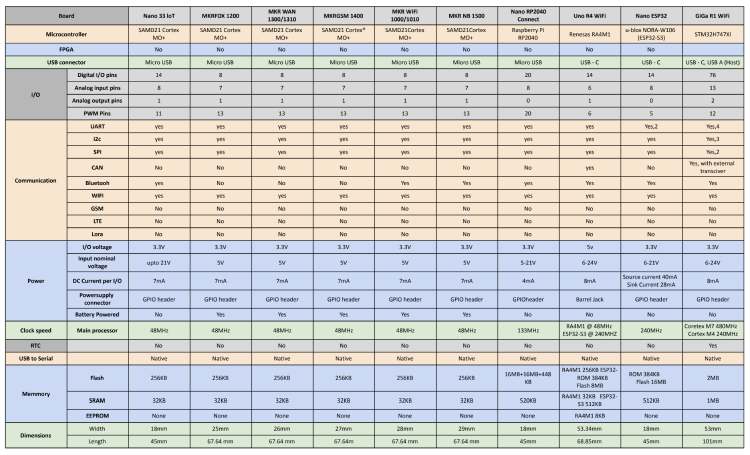
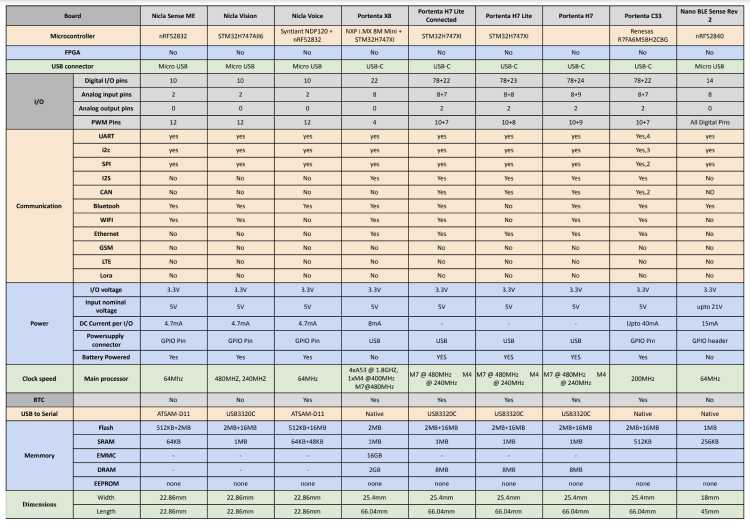





Section IoT-Boards, table overview: MKR WiFi 1000/1010, WiFi: "no".
But the MKR WiFi 1000/1010 has WiFi as the name says.